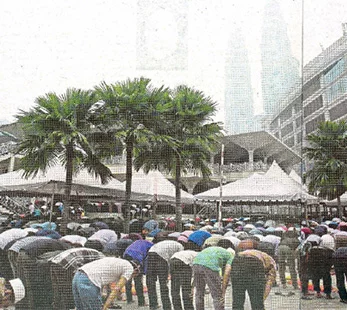EFFECTIVE MESSAGING: We must reclaim our brand of Islam if we want to distinguish ourselves from Daesh’s
THEY say that in the land of the blind, the one-eyed man is king. Today, carved out in parts of modern-day Syria and Iraq, there is just such a land. It is the land of dystopia and the one-eyed man is caliph. His vision is grotesquely blinkered, but it resonates far and wide in sympathy, support, and operations -from Raqqa to Paris, Baghdad to Beirut, Sousse to Sinai. Even Kota Kinabalu to Kuala Lumpur.
Countering the warped but cunning online narrative of Daesh (because it deserves the appanage of neither Islam nor a state) has been a struggle for many nations around the world. In October this year, the Malaysian government announced it would establish a Regional Digital Counter-Messaging Communications Centre to push back the spread of the Daesh propaganda. This Initiative was affirmed a month later when Prime Minister Datuk Seri Najib Razak and United States President Barack Obama met on the side-lines of the 27th Asean Summit and Related Summits.
The details of this centre are so far rudimentary. What we have been told is that the centre will promulgate counter narratives and present “the true Islam” using direct online engagement. While hosted by Malaysia, it will also be available to Asean and partner countries. The centre will be fully operated by the police and other enforcement agencies, including Immigration; but, is also expected to draw on relevant scholars and clerics. With the United States assisting the creation of the centre in training, equipment, and operational approach, it is likely that the centre may be modelled on the Sawab Center, which is a joint US-United Arab Emirates digital communications initiative based in Abu Dhabi and launched in July this year.
Effective messaging relates back to its constituent components: message, messenger, transmission, and target audience. Here are five points of consideration for Malaysia in moving forward with our centre and countering extremist views:
The starting premise of counter narratives is that credibility is key. If the centre is to counter Daesh’s binary, rejectionist worldview, then, the offsetting message of tolerance -if not acceptance -of diversity must be matched in speech and substance.
We cannot preach how God created nations and tribes among us so that we may get to know each other, yet retreat into our communal cocoons barbed with hateful rhetoric and action. If the centre is to expose the political, sectarian nature of the conflict in Syria, then the countervailing message must address the Sunni-Shia question in our own backyard with greater nuance. Left uncensured, the disturbing social media comments among Malaysians validating the slaughter of “the other” in foreign lands risks importing into our own soil the very clash we are trying to avoid;
SECOND, the counter-narrative conveyed must remain focused on Ellis regional context, particularly if the Gulf-based Sawab Center already functions similarly. With Daesh having originated in the Middle East and foreigners flocking there in the tens of thousands, it may be tempting to cast the message within that framework. It will be inevitable to discuss developments there, of course. But the narrative from the Malaysian centre should boldly recapture the historical testimony of this country and Southeast Asia.
This region’s brand of faith -in word and practice -was long marked by accommodation, tolerance and acceptance before insecurity in our own identity drove us to seek the favour of others. We would do well to reflect on, and reclaim, our past to push us into the future;
THIRD, the messenger is as important as the message. The militating appeal of Daesh is inherently anti-establishment. The group’s narrative strikes a chord with the disenchanted who seek an
This region’s brand of Islam is marked by tolerance, accommodation and acceptance
alternative and puritan nation-state free of imposed borders. Governments would, by default, lack the trust and legitimacy to offer a counter-narrative. They can still play an important role in sowing doubts about Daesh’s purpose and methods, but for counter-narratives to be personal and humanising, there must also be a pool of relatable messengers. These could include “formers” who renounced extremist ideology and violence, victims of terrorism, and mothers who lost runaway sons and daughters to the conflict of the Levant:
FOURTH, many of those drawn to the online narrative{s) of Daesh are young and partial to social media. Counter-narrative content must, therefore, cater to this audience and increasingly short attention spans; that is, they must be timely, responsive, concise (think 140-characters or less), creative, and above all, visual. Paternalistic lectures will be sure to receive short shrift; and,
FIFTH, there must be a keen recognition that what takes place online is often a transposition of larger issues offline. The drivers of violent extremism are multiple and complex. These range from personal trauma to a misplaced sense of indignance at injustice and oppression. Sometimes, there are single triggers; other times, there is a combination of factors that push or pull an individual towards terrorism. That is why countering terrorism demands a comprehensive, multi-stakeholder approach.
In pushing a counter-narrative that is consistent and aligned with the message of peace, we will no doubt be confronted with the difficult questions in our own nation that we will have to answer.
To narrate the authentic letter of Islam to those who misunderstand, abuse, and exploit the religion is admirable. To live up to the spirit of Islam’s final messenger and those who came before him, even more so.
Article by Elina Noor which appeared in New Straits Times, December 1, 2015.





